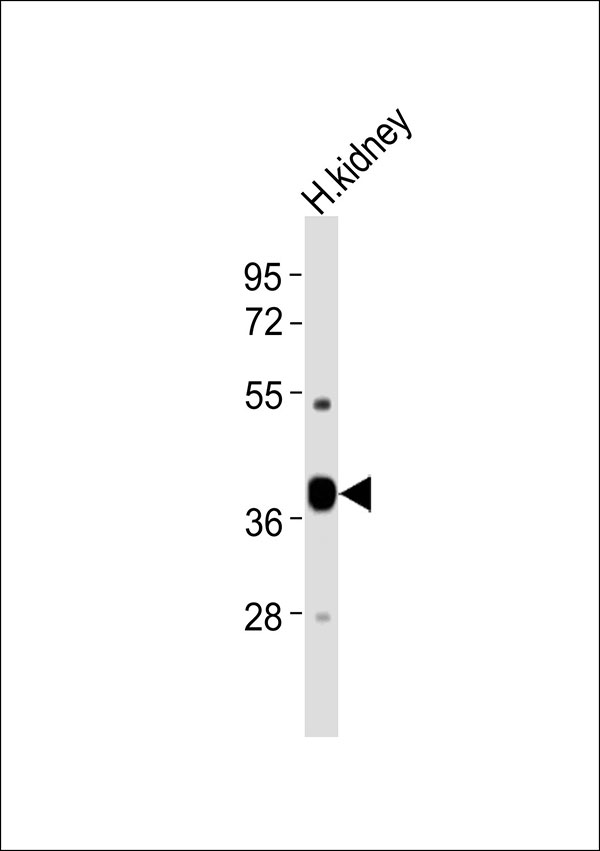AKR1A1 Antibody
Purified Rabbit Polyclonal Antibody (Pab)
- 产品详情
- 实验流程
- 背景知识
Application
| WB |
|---|---|
| Primary Accession | P14550 |
| Reactivity | Human, Mouse, Rat |
| Host | Rabbit |
| Clonality | Polyclonal |
| Calculated MW | 36573 Da |
| Gene ID | 10327 |
|---|---|
| Other Names | Alcohol dehydrogenase [NADP(+)], Aldehyde reductase, Aldo-keto reductase family 1 member A1, AKR1A1, ALDR1, ALR |
| Target/Specificity | KLH-conjugated synthetic peptide encompassing a sequence within the C-term region of human AKR1A1. The exact sequence is proprietary. |
| Dilution | WB~~ 1:1000 |
| Format | 0.01M PBS, pH 7.2, 0.09% (W/V) Sodium azide, Glycerol 50% |
| Storage | Store at -20 °C.Stable for 12 months from date of receipt |
| Name | AKR1A1 |
|---|---|
| Synonyms | ALDR1, ALR |
| Function | Catalyzes the NADPH-dependent reduction of a wide variety of carbonyl-containing compounds to their corresponding alcohols (PubMed:10510318, PubMed:30538128). Displays enzymatic activity towards endogenous metabolites such as aromatic and aliphatic aldehydes, ketones, monosaccharides and bile acids, with a preference for negatively charged substrates, such as glucuronate and succinic semialdehyde (PubMed:10510318, PubMed:30538128). Functions as a detoxifiying enzyme by reducing a range of toxic aldehydes (By similarity). Reduces methylglyoxal and 3-deoxyglucosone, which are present at elevated levels under hyperglycemic conditions and are cytotoxic (By similarity). Involved also in the detoxification of lipid-derived aldehydes like acrolein (By similarity). Plays a role in the activation of procarcinogens, such as polycyclic aromatic hydrocarbon trans-dihydrodiols, and in the metabolism of various xenobiotics and drugs, including the anthracyclines doxorubicin (DOX) and daunorubicin (DAUN) (PubMed:11306097, PubMed:18276838). Also acts as an inhibitor of protein S-nitrosylation by mediating degradation of S-nitroso-coenzyme A (S-nitroso-CoA), a cofactor required to S- nitrosylate proteins (PubMed:30538128). S-nitroso-CoA reductase activity is involved in reprogramming intermediary metabolism in renal proximal tubules, notably by inhibiting protein S-nitrosylation of isoform 2 of PKM (PKM2) (By similarity). Also acts as a S-nitroso- glutathione reductase by catalyzing the NADPH-dependent reduction of S- nitrosoglutathione (PubMed:31649033). Displays no reductase activity towards retinoids (By similarity). |
| Cellular Location | Cytoplasm, cytosol {ECO:0000250|UniProtKB:Q9JII6}. Apical cell membrane {ECO:0000250|UniProtKB:Q9JII6} |
| Tissue Location | Widely expressed. Highly expressed in kidney, salivary gland and liver. Detected in trachea, stomach, brain, lung, prostate, placenta, mammary gland, small intestine and lung |
For Research Use Only. Not For Use In Diagnostic Procedures.
Provided below are standard protocols that you may find useful for product applications.
BACKGROUND
Catalyzes the NADPH-dependent reduction of a variety of aromatic and aliphatic aldehydes to their corresponding alcohols. Catalyzes the reduction of mevaldate to mevalonic acid and of glyceraldehyde to glycerol. Has broad substrate specificity. In vitro substrates include succinic semialdehyde, 4- nitrobenzaldehyde, 1,2-naphthoquinone, methylglyoxal, and D- glucuronic acid. Plays a role in the activation of procarcinogens, such as polycyclic aromatic hydrocarbon trans-dihydrodiols, and in the metabolism of various xenobiotics and drugs, including the anthracyclines doxorubicin (DOX) and daunorubicin (DAUN).
REFERENCES
Bohren K.M.,et al.J. Biol. Chem. 264:9547-9551(1989).
Fujii J.,et al.Cytogenet. Cell Genet. 84:230-232(1999).
Barski O.A.,et al.Genomics 60:188-198(1999).
Ota T.,et al.Nat. Genet. 36:40-45(2004).
Ebert L.,et al.Submitted (JUN-2004) to the EMBL/GenBank/DDBJ databases.
终于等到您。ABCEPTA(百远生物)抗体产品。
点击下方“我要评价 ”按钮提交您的反馈信息,您的反馈和评价是我们最宝贵的财富之一,
我们将在1-3个工作日内处理您的反馈信息。
如有疑问,联系:0512-88856768 tech-china@abcepta.com.























 癌症的基本特征包括细胞增殖、血管生成、迁移、凋亡逃避机制和细胞永生等。找到癌症发生过程中这些通路的关键标记物和对应的抗体用于检测至关重要。
癌症的基本特征包括细胞增殖、血管生成、迁移、凋亡逃避机制和细胞永生等。找到癌症发生过程中这些通路的关键标记物和对应的抗体用于检测至关重要。 为您推荐一个泛素化位点预测神器——泛素化分析工具,可以为您的蛋白的泛素化位点作出预测和评分。
为您推荐一个泛素化位点预测神器——泛素化分析工具,可以为您的蛋白的泛素化位点作出预测和评分。 细胞自噬受体图形绘图工具为你的蛋白的细胞受体结合位点作出预测和评分,识别结合到自噬通路中的蛋白是非常重要的,便于让我们理解自噬在正常生理、病理过程中的作用,如发育、细胞分化、神经退化性疾病、压力条件下、感染和癌症。
细胞自噬受体图形绘图工具为你的蛋白的细胞受体结合位点作出预测和评分,识别结合到自噬通路中的蛋白是非常重要的,便于让我们理解自噬在正常生理、病理过程中的作用,如发育、细胞分化、神经退化性疾病、压力条件下、感染和癌症。






